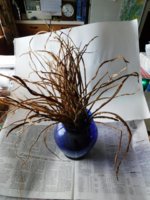I suspected that. You have confirmed it. Do corncobs burn out or otherwise last as long as more traditional pipes?
Meerschaum, ah, now I see it, Sepiolite : Mg4 Si6 O15 (OH)2 . 6H20 a hydrous Magnesium Silicate clay. Mohs scale hardness 2. Found in association with Magnesite, (Magnesium Carbonate), and usually associated with Serpentinacious rocks. I'll have to look in Sinkankas, and see if he mentions it. If it is not in Sinkankas, it is really obscure, or not mineralogically important. John Sinkankas' "Mineralogy" was first published in 1964, is still a standard Mineralogy reference book, aka: "the Bible".
Have you ever heard of pipes being made of Talc, aka: "Soapstone"? Mg3Si4O10 (OH)2. I have some big chunks of that, that I collected up in the Cascades a few years ago. Talc is soft, easy to carve, and resistant to heat, among its other properties. Talc is mineralogically similar to Sepiolite, and found in similar types of deposits. Just curious.
I also have a cluster of Actinolite, which is found directly associated with Talc. When found in its fibrous massive state, Actinolite is the semi-precious stone known as Nephrite Jade. (less valuable) Vs. the Jadeite Jade (more valuable). But, that is probably enough Mineralogy for one day.
Wes H.








